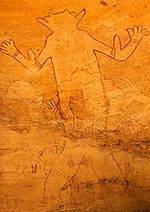User:Dzlinker/hist
Prehistoric period[edit]

The cave painting found around the Tassili n'Ajjer in northern Tamanrasset, and in other places, depicts scenes from every day life in the prehistoric Algeria, between 8000-BC and 4000-BC. They were executed by hunters during the Capsian period of the Neolithic age who lived in a savanna region, known then as the Green Sahara. Those paintings show giant buffalos, elephants, rhinoceros, and hippopotamus, animals that no longer exist in the now-desert area. The pictures provide the most complete record of a prehistoric Algerian history.

Earlier inhabitants of Algeria also left a significant amount of remains. At Ain Hanech[2] region (Saïda Province), early remnants (200.000-BC) of hominid occupation in North Africa were found. Neanderthal tool makers produced hand axes in the Levalloisian and Mousterian styles (43.000-BC) similar to those in the Levant.
According to some sources, Algeria was the site of the highest state of development of Middle Paleolithic Flake tool techniques. Tools of this era, starting about 30.000-BC, are called Aterian (after the archeological site of Bir el Ater, south of Annaba) and are marked by a high standard of workmanship, great variety, and specialization.
The earliest blade industries in North Africa are called Iberomaurusian (located mainly in Oran region). This industry appears to have spread throughout the coastal regions of the Maghreb between 15.000-BC and 10.000-BC. Neolithic civilization (animal domestication and agriculture) developed in the Saharan and Mediterranean Maghrib between 6.000 and 2.000-BC. This life richly depicted in the Tassili n'Ajjer paintings, predominated Algeria until the classical period.
The amalgam of peoples of North Africa coalesced eventually into a distinct native population that came to be called Berbers. Distinguished by cultural and linguistic attributes, the Berbers were typically depicted as "barbaric" enemies, troublesome nomads, or ignorant peasants by Roman, Greek, Byzantine, and Arab Muslim invaders. They were, however, to play a major role in the area's history.
Classical period[edit]

From their principal center of power at Carthage, the Carthaginians expanded and established small settlements along the North African coast; by 600-BC, a Phoenician presence existed at Tipasa, east of Cherchell, Hippo Regius (modern Annaba) and Rusicade (modern Skikda). These settlements served as market towns as well as anchorages.
As Carthaginian power grew, its impact on the indigenous population increased dramatically. Berber civilization was already at a stage in which agriculture, manufacturing, trade, and political organization supported several states. Trade links between Carthage and the Berbers in the interior grew, but territorial expansion also resulted in the enslavement or military recruitment of some Berbers and in the extraction of tribute from others.
By the early fourth century BC, Berbers formed the single largest element of the Carthaginian army. In the Revolt of the Mercenaries, Berber soldiers rebelled from 241 to 238-BC after being unpaid following the defeat of Carthage in the First Punic War. They succeeded in obtaining control of much of Carthage's North African territory, and they minted coins bearing the name Libyan, used in Greek to describe natives of North Africa. The Carthaginian state declined because of successive defeats by the Romans in the Punic Wars.

In 146-BC the city of Carthage was destroyed. As Carthaginian power waned, the influence of Berber leaders in the hinterland grew. By the second century BC, several large but loosely administered Berber kingdoms had emerged. Two of them were established in Numidia, behind the coastal areas controlled by Carthage. West of Numidia lay Mauretania, which extended across the Moulouya River in modern day Morocco to the Atlantic Ocean. The high point of Berber civilization, unequaled until the coming of the Almohads and Almoravids more than a millennium later, was reached during the reign of Massinissa in the second century BC.
After Masinissa's death in 148 BC, the Berber kingdoms were divided and reunited several times. Massinissa's line survived until 24 AD, when the remaining Berber territory was annexed to the Roman Empire.
